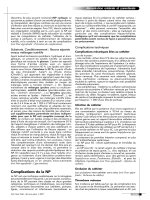10 nutrition recovery video
Bạn đang xem bản rút gọn của tài liệu. Xem và tải ngay bản đầy đủ của tài liệu tại đây (458.72 KB, 13 trang )
UNIVERSITY
Recovery
Nutrition
Calories for Massing and
Cutting
Lesson Overview
• Understand the role of calories in recovery and muscle growth
• Understand proper rates of muscle growth and fat loss
• Evaluate training status and apply appropriate calorie level for goals
Calories and Function
• Providing energy substrate for all body processes
• Providing energy to restore energy stores and power recovery
process
• Providing raw materials to rebuild damaged components from
training
• Calories are a primary recovery strategy before other nutrition
strategies
• Our concern is muscle and fat gain/loss in relation to calories
Factor effecting rate of muscle gain and
retention
• Genetics and Drugs
• Sufficient training stimulus to force adaptation and Training
Experience
• Calorie intake
• Sufficient protein, carbohydrate, fats
• Sufficient sleep and relaxation
• Body-fat percentage
• Meal frequency, Nutrient Timing, supplements
Effect of Calorie Level on Protein Response
Hypocaloric (Calorie Deficit)
• 20% calorie deficit shown to decrease protein synthesis 19% following a
meal
• 500kcal deficit for 5 days decreased protein synthesis by 27% and
resistance training only restored rates to resting levels
• Increased rate of protein as fuel source
• Decrease in mTOR signaling, Increase in AMPK signaling
• Same bout of training less effective for a growth response
Eucaloric State (Maintenance)
• Anabolic response to resistance training is still suboptimal
• Loss in proteins with protein accretion is at a balance
• Suboptimal to maximize recovery and growth
Hypercaloric (Calorie Surplus)
• Stimulates anabolism even without resistance training
• Optimize protein synthesis and minimize proteolysis
Research on Calorie Surplus
• Untrained subjects, 2000kcal surplus per day for 8 weeks increased
fat free mass by 6.6lbs vs control group added no mass and ate at
maintenance calories (Rozenek et al)
• In well trained subjects, 600kcal surplus or ad libitum (small surplus
of 200-300kcal), for 12-week resistance training period. Gain in
muscle mass were not significantly different but large surplus group
had 5x the fat gain (1.1kg vs 0.2kg) (Garth et al)
• In male BBer, 6,000 calorie diet vs 4500 calorie diet, resistance
trained 6 days per week for 4 weeks. Muscle mass (2.7% vs 1.1%) Fat
gain (7.4% vs 0.8%)
Ribeiro et al 2019
PERCENTAGE %
8
6
4
2
0
Muscle Mass
600kcal
Fat Mass
Control
Research on Calorie Deficit
•
•
•
•
500kcal deficit does not always equal 1lb of fat loss
Metabolic adaptation ranges per individual
Tissue loss during a deficit is related to size of the deficit
Weekly loss of 1kg vs 0.5kg over 4 weeks resulted in 5% decrease in
bench press strength and 30% greater drop in testosterone in
women
• Weekly loss of 1.4% vs 0.7% in athletes during calorie restriction for 4
to 11 weeks resulted in fat mass reduction of 21% in fast group and
31% in slow group, lbm increased 2.1% in slow group.
• Weight loss rates of 0.5-1.0% ideal for lean body mass retention
• Leaner you become slower the fat loss rate must be. Research on
BBers increasing energy deficit in later stage of prep had the greatest
loss in lean body mass.
Estimating Your Training Experience
• Training Experience large dictator of rate of progress
• Beginner: Brand new to training
• Novice: Still able to progress most training loads week to week
• Intermediate: Able to progress most training loads month to month.
• Advanced: Progression in loads over months or mesocycles
*You can shift back down based on AAS/GH/slin usage
Calorie Starting Points
Massing
10-20% calorie addition
upper end for beginners
lower end of advanced
0.25-0.5% weight increase per week or every other week
Cutting
20-30% calorie reduction
Lower end for low body fat and advanced level
Higher end for high body fat and beginners
0.5-1.0% weight loss per week
AAS/GH/Slin will alter rates and shift you to more aggressive trajectory
in muscle gain/retention and fat loss
Calorie Cycling
• Rotation of calories to optimize physiology and endocrinology for
improved body composition.
• Nutrient Timing Strategy
• Calories based on daily energy expenditure
• Lean Massing and Increased muscle retention cutting strategy
• Advanced strategy for weak body parts
Massing
Low/High days
Cheat Meals
Cutting
Low/High days
Refeed days
Diet Breaks
Cheat meals
Calorie Cycling Set up
Intermediate Bulk Male
Maintenance calories: 3000kcal average per day
15% calorie surplus: 3450kcal average per day
Estimate calorie burned training: 200-500 per hour
Training 4 days per week, 1.5 hours (~700kcal)
Training days: 3650kcal Off day: 3250kcal. (average kcal ~3500)
Intermediate Cut Male
Maintenance calories: 3000kcal average per day
25% calorie deficit: 2250kcal average per day
Estimate calorie burned training: 200-500 per hour
Training 4 days per week, 1.5 hours (~700kcal)
Training days: 2550kcal Off days: 1850kcal (average kcal ~2250)
*monitor visuals, anthropometrics, performance, recovery, rate of
change and adjust in 1-2 weeks.
Conclusions
• Calories are the primary nutrition strategy to recover and grow
• Hypercaloric state will optimize results over a deficit or maintenance
• Calories level should be based off goals, training level, and rate of
progress
References
Ribeiro AS, Nunes JP, Schoenfeld BJ, Aguiar AF, Cyrino ES. Effects of
Different Dietary Energy Intake Following Resistance Training on
Muscle Mass and Body Fat in Bodybuilders: A Pilot Study. J Hum Kinet.
2019;70:125-134. Published 2019 Nov 30. doi:10.2478/hukin-20190038
Helms ER, Aragon AA, Fitschen PJ. Evidence-based recommendations
for natural bodybuilding contest preparation: nutrition and
supplementation. J Int Soc Sports Nutr. 2014;11:20. Published 2014
May 12. doi:10.1186/1550-2783-11-20
Iraki J, Fitschen P, Espinar S, Helms E. Nutrition Recommendations for
Bodybuilders in the Off-Season: A Narrative Review. Sports (Basel).
2019;7(7):154. Published 2019 Jun 26. doi:10.3390/sports7070154
Schoenfeld B. Science and Development of Muscle Hypertrophy.
Champaign, IL: Human Kinetics; 2021.









